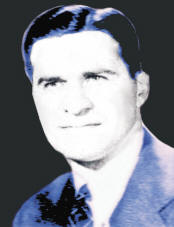Mars G. Fontana (1910-1988)
Mars G. Fontana, a world-renowned educator and corrosion engineer, died February 29, 1988. He was was one of the world's pioneers in research establishing basic scientific knowledge in the phenomenon of corrosion and it applications in engineering. In addition to his noteworthy technical achievements, Fontana was an outstanding administrator and stimulating teacher. Born in Iron Mountain. Michigan, on April 16, 1910, Fontana received a B. S. in chemical engineering (1931) and an M.S. (1932) and Ph.D. (1935) in metallurgical engineering from the University of Michigan.

From 1929 to 1934 he served as a research assistant in the university's Department of Engineering, where his work included investigations of scaling of steel at forging temperatures, development and use of apparatus for vacuum fusion analysis for gases in steels, high-temperature, creep of metals and alloys, and also basic work on the thermodynamics of steelmaking.
From 1934 to 1945 Fontana, worked far E.I. du Pont de Nemours and Company,
in Wilmington, Delaware , as a metallurgical engineer and group supervisor.
There he devoted limited time to research while concentrating largely on plant
and design engineering, This included organizing work on materials of construction
in various Du Pont production departments and developing materials and designs
for acid service. He also pioneered industrial uses of nylon and Teflon. Four
patents were assigned to Du Pont in connection with his corrosion work.
This
early practical experience set the stage for his research, writing, and teaching
that followed during the succeeding thirty years of professional activity as
professor and chairman in the Department of Metallurgical Engineering at The
Ohio State University (OSU). In 1945 he was named a professor of metallurgical
engineering at OSU, and in 1948 department chairman and director of the Corrosion
Center, the largest university effort in corrosion research in the United States.
He was named a regents professor in 1967 and chairman emeritus in 1975.
He was known as an excellent teacher, lecturer, and researcher, but also a considerate and efficient leader. At OSU he was particularly effective in bringing about the building of new laboratories, recruiting and developing outstanding young faculty members, and participating in the administration of the college and university. During his tenure, $3 million worth of new facilities for metallurgical engineering were constructed, and research under contract grew to $1 million a year. At OSU he was called upon to serve on various faculty committees, including the Faculty Advisory Committee to the president and Board of Trustees, Faculty Council, Advisory Council of the Engineering Experiment Station, and Executive Committee of the College of Engineering.
Throughout his career, Fontana merged science and engineering to clarify the mechanisms of corrosive attack of engineering materials by aggressive environments, and to develop and recommend inhibitors, coatings, and electrolytic and other means to protect engineering structures. These efforts led to his famous textbook Corrosion Engineering, published by McGrawHill in 1967. The author of two hundred technical papers in recognized journals, he also authored Corrosion: A Compilation, published by Hollenback Press in 1957.
Fontana was elected a member of the National Academy of Engineering in 1967 and later served on the National Research Council's Committee on Ocean Engineering. He served as an honorary member of the American Society for Metals (ASM) in 1969 and was a fellow of the ASM in 1970, of the Metallurgical Society of the American Institute of Mining, Metallurgical, and Petroleum Engineering (AIME) in 1971, ant} of the American Institute of Chemical Engineers in 1972. He served as president of the National Association of Corrosion Engineers in 1952, chairman of the Corrosion Division of the Electrochemical Society in 1948-1949, and chairman of the Columbus Chapter of the ASM in 1948.
He was editor of the NACE journal Corrosion from 1962 to 1974. In 1962-1963 Fontana was named to a six-man corrosion exchange between the United States and the USSR, and from 1972 to 1975 served as a public member of the Technical Pipeline Safety Standards Committee of the U.S. Department of Transportation. He presented the Plenary Lecture at the Second International Congress on Corrosion in 1963 and was the Edward DeMille Campbell Lecturer of ASM in 1970. He held eight patents including that for Alloy FA-20, a standard alloy for many corrosive services. His Alloy DC4MCu was patented by OSU, and he invented Duriron anodes for cathodic protection that are used to protect buildings at the Kennedy Space Center.

Connect with us
Contact us today